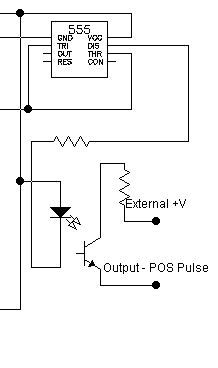The logic "1" output of the preceeding stage above will bring pin #2 and pin #6 high, causing pin #7 of this 555 to conduct and bring the cathode of the LED down causing current to stimulate the emission of light to the base of a light-sensitive transistor, causing it to conduct, as well.
With this process, current from the emitter will be sent to the gate of a thyristor, causing it to conduct for the rest of the alternating-current cycle. The process will be repeated with the introduction of another negative-going edge at the input.
Note that, once triggered, the thyristor will maintain conduction until the current falls below the physical "latching current of the thyristor.
|

|

